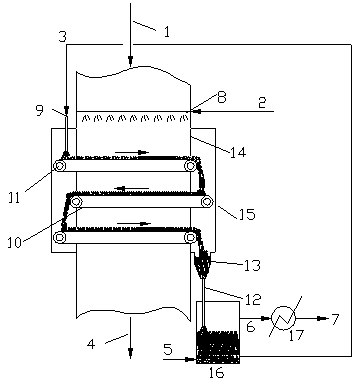Low-temperature denitration catalyst and application thereof
A low-temperature denitrification and catalyst technology, applied in the field of flue gas denitrification, can solve the problems of NOx emission that cannot meet the standard, high investment and operation costs, and small operating flexibility of fixed beds, so as to reduce investment and operation costs, increase density, and reduce energy consumption. consumption effect
- Summary
- Abstract
- Description
- Claims
- Application Information
AI Technical Summary
Problems solved by technology
Method used
Image
Examples
Embodiment 1
[0052] At room temperature (20°C), mix water, absolute ethanol, aluminum chloride, polyethylene glycol, and formamide evenly, and then add pyridine. The contents of each component of the mixture are by weight: water 23%, ethanol 22% , aluminum chloride 20%, polyethylene glycol (viscosity average molecular weight 1 million) 0.3%, formamide 1%, pyridine 33.7%. After mixing evenly, the resulting mixture is added dropwise into an oil column at 20-50°C to form microspheres, aged at 45°C for 48 hours, and then soaked in a mixture of ethanol and water for 48 hours. After soaking, remove After the liquid phase, dry at 40°C until the product no longer loses weight significantly. Then calcined at 600°C for 6 hours to obtain a microsphere alumina carrier; impregnated the alumina carrier with an equal volume of impregnating solution containing iron nitrate and manganese nitrate, then dried at 80°C for 8 hours, calcined at 550°C for 6 hours, and cooled to room temperature. The microspheri...
Embodiment 2
[0055] At room temperature (20°C), mix water, absolute ethanol, aluminum chloride, polyethylene glycol, and formamide evenly, and then add pyridine. The contents of each component of the mixture are by weight: water 31%, ethanol 29% , aluminum chloride 16%, polyethylene glycol (viscosity average molecular weight 2 million) 0.5%, formamide 3.5%, pyridine 20%. After mixing evenly, the resulting mixture was added dropwise into an oil column at 20-50°C to form microspheres, aged at 60°C for 24 hours, and then soaked in ethanol for 48 hours. After soaking and removing the liquid phase, it was placed in Dry at 50°C until the product no longer loses weight significantly. Then bake at 750°C for 5 hours to obtain microsphere alumina carrier; impregnate the alumina carrier with equal volume of impregnation solution containing iron nitrate and manganese nitrate, then dry at 100°C for 5 hours, bake at 550°C for 5 hours, and cool to room temperature , to obtain microspherical denitration ...
Embodiment 3
[0060] FCC regeneration flue gas flow rate is 150,000 Nm 3 / h, temperature is 650°C, pressure is 10kPa, NOx concentration is 600mg / Nm 3 , SO 2 The concentration is 1000mg / Nm 3 , SO 3 The concentration is 20mg / Nm 3 , the dust content is 200mg / Nm 3 . NOx emission standard is 200 mg / Nm 3 .
[0061] The catalyst adopts microspherical denitration catalyst A.
[0062] First, the FCC regenerated flue gas passes through the boiler to take heat, the temperature is lowered from 650°C to the reaction temperature of 200°C, and the flow rate of the mixed gas containing ammonia is 1800Nm 3 / h, where the ammonia gas fraction is 4%, the stripping gas is 0.8MPa, superheated steam at 420°C, and the flow rate is 15Nm 3 / h. This embodiment adopts a mobile reactor, and the size of the inner sealed chamber of the reactor is 8m in length × 6m in width × 8m in height; the reaction time is 0.5s, and 3 layers of conveyor belts are set. The height of the catalyst bed on each conveyor belt is 30...
PUM
| Property | Measurement | Unit |
|---|---|---|
| diameter | aaaaa | aaaaa |
| specific surface area | aaaaa | aaaaa |
| distance | aaaaa | aaaaa |
Abstract
Description
Claims
Application Information
 Login to View More
Login to View More - R&D
- Intellectual Property
- Life Sciences
- Materials
- Tech Scout
- Unparalleled Data Quality
- Higher Quality Content
- 60% Fewer Hallucinations
Browse by: Latest US Patents, China's latest patents, Technical Efficacy Thesaurus, Application Domain, Technology Topic, Popular Technical Reports.
© 2025 PatSnap. All rights reserved.Legal|Privacy policy|Modern Slavery Act Transparency Statement|Sitemap|About US| Contact US: help@patsnap.com



